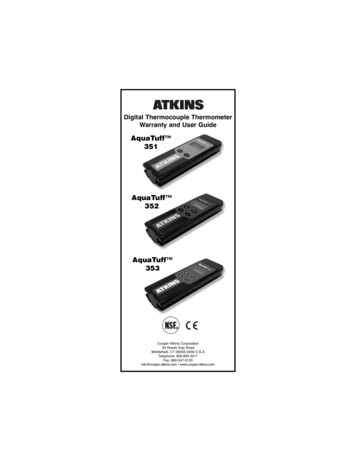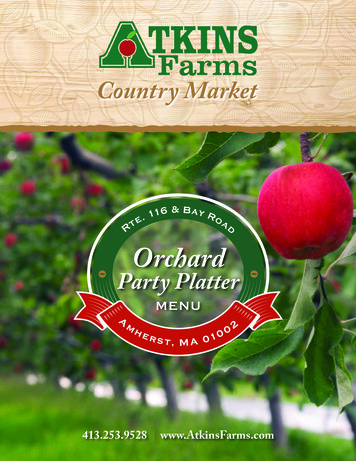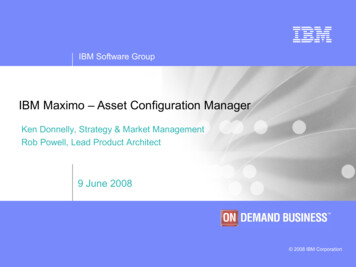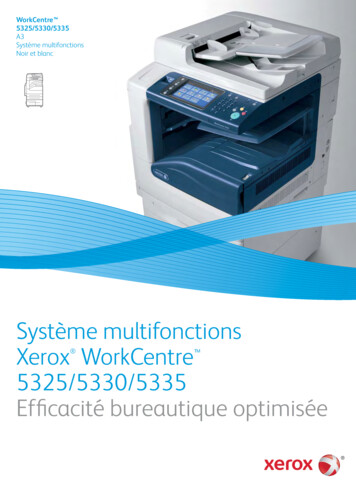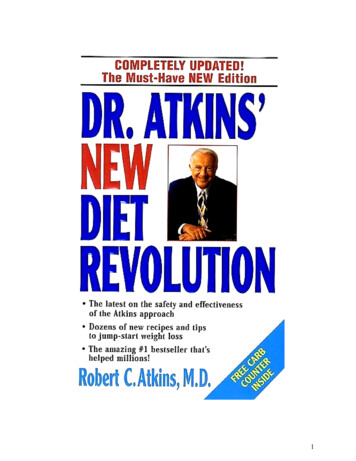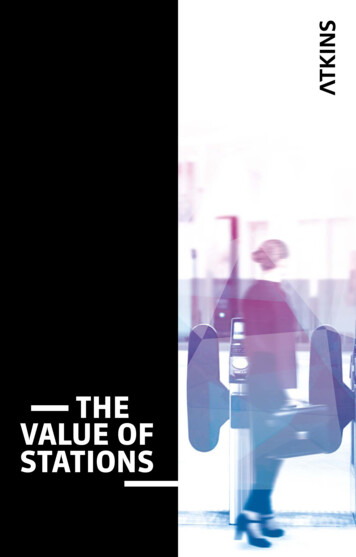
Transcription
THEVALUE OFSTATIONS
“GOOD TRANSPORT HELPSPEOPLE GET AROUND AND GETON AND IS CRUCIAL TO DRIVINGECONOMIC GROWTH. THAT ISWHY THE GOVERNMENT IS HEAVILYINVESTING IN TRANSPORT ACROSSTHE COUNTRY, SPREADINGOPPORTUNITY AND GROWTHAND BRINGING OUR COUNTRYCLOSER TOGETHER.”UK TRANSPORT MINISTER
CONTENTS INTRODUCTION ˆ ˇ DALMARNOCK FIRST STOP REGENERATIONCUSTOM HOUSETHINK MODULAR ˇ CAMBRIDGEDESIGNED FOR CAMBRIDGEBOND STREETBIRMINGHAMAN UPGRADE TOCOLLABORATIONA COLLABORATIVEJOURNEY TO THE FUTURE GLASGOWA TIMELESS STATIONCONCLUSION
INTROStations are no longer places thatpeople just pass through, they areplaces where people live, work andshop and can form the very heartof our communities. Stations canbe transformative – the catalyst forgrowth, regeneration or reinvention.The foundation for a new city, regionor economic hub. Increasingly, transportation infrastructureis a key driver to the development of ourcities, and the development of our citiesis, undoubtedly, essential to the growthof our economy. Whichever way youlook at it, transportation is a key enablerto our continued economic prosperity.So, amidst all this, we need to ask:What is the true value of a station?At Atkins we believe good station designis crucial to maximising the station’svalue, not only to its owners andoperators but to the community it sitsin. Designing a station isn’t simply aboutdesigning a building that helps peopleget from X to Y – it’s about designersunderstanding the role a station canplay in bringing value to a city and itsinhabitants, and actively designing thestation so that it maximises that value.So how can a station design add real value?Our experience points to the following: DEVELOPMENT OFTHE VALUE PROPOSITIONFor a new station to be transformative,the station must deliver both function andexperience. Function means the station willdeliver the capacity and throughput to avoidcongestion and delay. Experience meansthat the design will promote other attributesthat will drive value for users of the stationby providing other opportunities (typicallyin retail, leisure, commercial or residential)depending on the specifc location, form anddensity of the surrounding area.- PLACEMAKINGThe successful design of a station dependson how it integrates and works with thesurrounding area – whether it’s in a high densityurban area, a growth node outside a city or alocal interchange in a small town. Placemakingrequires planners to meet the needs of the localarea, in particular the community’s economy,culture, history and way of life.TAKE STAKEHOLDERS ONTHE DESIGN JOURNEYThe design must involve everyone with a stakein its success: the asset owner, tenants, localauthorities, local land owners and developers,and the community that will use it. Workingwith these stakeholders is critical to unlockingthe potential of a station and capturing its truevalue as a growth enabler and successfullynavigating the planning stages of schemedevelopment. -MAXIMISING VALUECAPTURESuccessful placemaking and the developmentof a new or enhanced value proposition willpromote increased economic activity and bothland value and rental potential will increase.Mechanisms for capturing that value must bein place otherwise schemes will be delayed oreven fail. ˆDESIGNING FORRESILIENCEStations tend to be there for longer thanthe surrounding built environment, so theyneed to be able to accommodate impacts ofeconomic, social and technological changesthat will happen over time. It’s important tobuild resilience into our designs, and ensurethey respond to the city and its inhabitantswell into the future. When designing a stationwe can’t just think about the building inisolation. We need to think of every possibleway end users will use the space – both nowand in 20 or 50 years’ time – and look outtowards its local environment and how it ftsin this context.The six examples of station designs that followdemonstrate how stations can add value.They also show how throughout our work wehave adhered to the basic principles of a trulycollaborative delivery team, minimising waste,debris and road traffc, technology to enableeffciency and collaboration, and health andsafety above all.LIAM HARRISONMARKET DIRECTOR, TRANSPORTORIENTED DEVELOPMENTˆ
FIRST STOP REGENERATIONBY SCOTT DICKSON,ASSOCIATE ARCHITECT ˇ
The reinvention of Dalmarnock Station startedas a way to better serve the needs of theCommonwealth Games District in 2014, but nowforms a crucial part of the ongoing, long termregeneration of Glasgow’s East End.Working in partnership with multiple stakeholders– Transport Scotland, Network Rail, Glasgow CityCouncil, Strathclyde Passenger Transport and ClydeGateway – we produced a striking design for thestation that has become a dramatic backdrop to railtravel to and from Dalmarnock.Up close, the station is designed as a tranquilbackground to the kinetic activity of travel, but seenfrom a wider perspective it is much more than this.Dalmarnock Station represents vital investment inpublic transport and urban infrastructure in a settingdesigned to make the most of the rail lines relationshipto its context and community. Designed to take fullcognisance of the future Clyde Gateway masterplan,the new station design interfaces seamlessly withexisting public routes and future public spaces tocreate a rail hub embedded in its context.Ultimately, the design of Dalmarnock Station hasdelivered value by constructing a relationship withthe past, present and future of Dalmarnock and itswider districts.“THE WORK AND INVESTMENTFROM OUR VARIOUS PARTNERSTO TRANSFORM DALMARNOCKSTATION AND PROVIDETHIS FANTASTIC FACILITYRECOGNISES THE VITAL ROLEPUBLIC TRANSPORT PLAYSIN ENSURING DELIVERY OFA SUCCESSFUL GAMES”DAVID GREVEMBERGGLASGOW COMMONWEALTHGAMES CHIEF EXECUTIVE
Best Future BuildingAward 2012(Scottish Design Awards)Rail Station of the YearShortlist 2014(National Transport Awards)The design of the new station allows the surviving,original aspects of the monolithic stone masonrystation to be retained and contrasted against a newskin of glass and light. This allows critical aspects ofDalmarnock’s proud manufacturing heritage to formpart of the station’s daily life again. We have alsoused the new works to transform an existing heavygoods bridge into a public entrance which will lead toa future public event space. “DALMARNOCK STATIONWAS A TRANSFORMATIVEPROJECT UNDERTAKEN INPARTNERSHIP WITH ATKINSWHO RESPONDED TO THEBRIEF BY DELIVERING ASOLUTION WHICH SIMPLIFIEDA HIGHLY COMPLEX SITE”MARTIN MCKAYEXECUTIVE DIRECTOR OFREGENERATION AT CLYDE GATEWAYAt its start, Dalmarnock Station was all about theCommonwealth Games. Acting as the main transporthub for the athletics, velodrome and openingceremony venues, the station was designed to copewith the Games’ major events and record ticket sales.However the future for Dalmarnock Station istwo-fold. Firstly to provide modern, sustainable railtravel, connecting the increasing number of residentsof Dalmarnock to Central Glasgow and beyond.Secondly to continue to assist with the regenerationof Dalmarnock as a place of work and business,encouraging people to see the new East End ofGlasgow as a viable commercial district.Best Public BuildingCommendation 2014(Scottish Design Awards)Best Public BuildingCommendation 2014(Glasgow Institute of Architects)Infrastructure Architect of the YearShortlisted project 2016(Building Design: Architectof the Year Awards)
A COLLABORATIVEJOURNEYTO THE FUTUREBY HALA LLOYD,ASSOCIATE ARCHITECT
JOn approaching Birmingham New Street Stationtoday you are instantly struck by the sight of itsmassive LED media ‘eyes’ and the undulatingribbon of polished stainless steel that wrapsitself around the whole station. What was amonolith of 1960s brutalist architecture has beentransformed into a futuristic testimony to digitaltechnology and 21st century design.There is no mistaking the central purpose of this citycentre landmark. Its very design refects the dynamicmovement of trains arriving and departing at thismajor interchange, all set against the backdrop ofcommercial and retail neighbours within the heart ofthe UK’s second biggest city. Considered to be the ‘largest refurbishment projectin Europe’ at the height of its construction, itskey features exemplify the many challenges andopportunities that present themselves to all thosewho are involved with the redevelopment andexpansion of major transport interchange hubs ftfor the future. Namely, how to expand and developfacilities on congested brownfeld sites within largeurban metropolitan areas such that visionary designand much needed growth can be achieved whilstlimiting unwelcome disruption to people and theirdaily lives.This delicate balancing act requires input from allstakeholders. It needs people with the right skills andexpertise engaging at the right time and with the rightremit in order to address the many complex issues thatare ultimately encountered on such projects.The renewal of Birmingham New Street Station,based on the award winning and visionary 2007competition entry from Foreign Offce Architects(now AZPML), was only made possible by way of ajoint design and delivery team approach led andchampioned by Network Rail and its partner Macewith Atkins as lead consultant throughout thekey design and construction stages. This broughttogether team members with the necessary skills,knowledge and expertise to develop and implementcomplex and, on occasion, ground breaking solutionswhilst ensuring the safety of all involved remained atthe forefront of our endeavours.“WHAT I’M MOST PROUD OFIS HOW SEAMLESSLY THEDESIGN BRINGS TOGETHERALL OF THE DIFFERENTTRANSPORT MODES,RETAIL OUTLETS ANDOUTDOOR SPACES” ˆ
Looking at the station today, it is most impressivehow seamlessly the design brings together all of thedifferent transport modes, retail outlets and outdoorspaces. We really have achieved a station that reads asone with its external environment and that has becomepart of the urban realm. It’s not just somewhere you goto catch a train anymore – it’s part of a normal walkingroute in the city, and a place where people want to be.As an integrated major interchange, transport huband retail centre, New Street station has become a‘destination’ for social, retail, commerce and leisureactivities. It is now established as a major arteriallink within the heart of the city centre, transformingthe way people move across the city and acting asa signifcant catalyst for further regeneration of theneighbouring areas.Successful integration of the station has been a directresult of the positive input and interface achievedwith key stakeholders and designers from a variety ofdisciplines and organisations including specialists inareas such as fre safety, anti-terrorism security, wayfnding , communications, highways and civic design. ˇIt’s a vital approach to current and future majorinterchange station design which recognises thegrowing need for providing mixed-use and fexiblepublic spaces that fulfl both current operationalcriteria and future demands.The invaluable experiences gained from theredevelopment of Birmingham New Street Stationneed to be shared and disseminated for future majorinfrastructure projects to help inform and defne thedesign and implementation methodologies that canhelp us achieve overall project success, and mostimportantly, create maximum value for everyone.
A TIMELESSSTATION BY LOGAN DOAK,SENIOR ARCHITECT
Opened by the Caledonian Railway in 1879,Glasgow Central Station is one of those timelessstations that is recognised both nationallyand internationally. Both its external andinternal built fabric are protected by statute,with features like its highly decorated ashlarsandstone and granite facades, porte-chochereand arcading and delicate fligrees of glass andcast-iron all contributing to its A category listing. “OUR REFURBISHMENTAIMED TO PROVIDE A HIGHIMPACT MODERN DESIGNTHAT RESPECTED THEORIGINAL STATION BUTTHAT DID NOT RESORT TOPASTICHE ALL WITHINACHIEVABLE COST ANDTIME LIMITS PRIOR TO THECOMMONWEALTH GAMESIN †“‘”IIn November 2013, Network Rail invited us to puttogether proposals for a series of interventions withinthe station that would elevate the quality of passengerexperience via improved way-fnding, lighting,signage, materials and overall levels of design.Recent refurbishment works undertaken on the stationhad been of poor quality, both in terms of materials anddesign. This work has unsurprisingly dated badly andappears inconsistent with the Victorian architecture ofthe original station.Our refurbishment aimed to provide a high impactmodern design that respected the original station butthat did not resort to pastiche – all within achievablecost and time limits prior to the CommonwealthGames in 2014.Our solution? To reconnect routes through thestation by enhancing the visibility of critical pathsand gateways. This reduces the reliance on complexsignage by allowing the material and form of thesenew spaces to inform passengers of their function.In practice this meant heightening the presence ofthe low level station within the upper concoursethrough the introduction of a tall, delicate archwaystructure which recalls the station’s original decorativegateways and barriers.
It also meant intensifying the signifcance of secondaryaccess to Union Street through the introduction oflarge format porcelain tiles which create a dialoguewith the ashlar sandstone and granite of the originalbuilding. The large format gates, like the archway,feature ornate metalwork based on the motifs andsymbols found in the original station environment.Although signifcant in scale, the new arch andgateways are elegantly proportioned and delicatelyperforated, and laser cut steel plates help belie theirstructural weight.With these, we see a more timeless, elemental seriesof natural materials that respond to the originalstation environment, and that set the benchmark forany future development at Glasgow Central Station.Our designs have brought the station’s historical valueto the forefront, while being mindful of Glasgow’sbright future. Our work at Glasgow Central Station receiveda Scottish Design Award in 2015 for ‘Reuseof a Listed Building’ and a commendation inarts and leisure from the Glasgow Instituteof Architects in the same year. It also playeda part in the station’s recognition as NationalTransport Award’s and Europe’s 2014 “Stationof the Year”.
THINKMODULARBY ED NEWMAN’SANDERS,TECHNICAL DIRECTOR ˆ ˆ
Looking at images of Custom House Stationin London, most people would never guessthe majority of it was created in a factory andassembled on site by a gantry crane. This is astation that can change all of our assumptionsabout prefabricated, modular design. It is notonly an exemplar ‘kit of parts’ structure, but anaesthetically beautiful building.Custom House was a unique opportunity for designand construction. Each of the 10 new stationsbeing delivered by Crossrail has a unique character,designed to refect its surroundings and best serve itslocal community. Custom House presented a numberof constraints – a very narrow site working near busyrailway lines and roads, existing utilities and overheadpower lines and a public right of way that had to bemaintained at all times – that meant traditional buildoptions were not viable. With Laing O’Rourke, Arup, Crossrail, and Allies andMorrison, we formed a strategy for the constructionof Custom House that included pre-fabricated andstandardised architectural structural components, witha ‘kit of parts’ forming the platform, columns, cofferedconcourse slab and roof.With this approach we could minimise time on site,drive down programme time and preliminary costs,reduce vehicle movements and deliveries to the siteand ensure a more consistent, higher quality build.Repetitious units, manufactured in factory conditionsto a high standard and consistent fnishes, weredelivered to site in batches to coincide with theconstruction programme. It is effcient design andconstruction at its best.“WITH THIS APPROACHWE COULD MINIMISE TIMEON SITE, DRIVE DOWNPROGRAMME TIME ANDPRELIMINARY COSTS, REDUCEVEHICLE MOVEMENTS ANDDELIVERIES TO THE SITE ANDENSURE A MORE CONSISTENT,HIGHER QUALITY BUILD” ˇ
What’s more, we modelled all of the componentsat Custom House in 3D, providing an invaluablecommunication tool to aid conversations betweenteams around buildability, site inductions, logistics,sequencing and health and safety. The 3D modelwas also linked to the project programme in Synchroto visualise and plan the complex sequence ofinstallation. This was in turn linked to Laing O’Rourke’sfactory database. By using unique QR codes – or quickresponse barcodes – on each component, we wereable to track, plan and record the status of each ofthe 887 precast components from the design stagethrough to casting, delivery and installation on site.Once on site, mobile devices scanned the QR code andbrought up the necessary quality form to complete.This provided an effcient way to carry out all qualityand health and safety checks, maximising traceabilityand simplifying the handover process. “BY USING UNIQUE QR CODESON EACH COMPONENT, WEWERE ABLE TO TRACK, PLANAND RECORD THE STATUS OFEACH OF THE † PRECASTCOMPONENTS FROM THEDESIGN STAGE” Years from now the station will welcome regional andinternational visitors to London’s largest conferencecentre, ExCeL London, and create an importanttransport interchange between the Elizabeth line, theDLR and local buses. It will also provide a focus for theregeneration of the local area, the London Borough ofNewham. While no one may remember its modular,‘kit of parts’ history, the community will be left with anenduring elegant station for years to come.All Custom House images Crossrail
DESIGNED FORCAMBRIDGEBY QUINTIN DOYLE,SENIOR ARCHITECTURAL DESIGNER
Cambridge North Station creates a newgateway to Cambridge and its northern fringes.The development is expected to serve over 3,000passengers per day, and is seen as a key pieceof Cambridgeshire’s transport infrastructure.It will alleviate congestion in the city centreand open up access to Cambridge Science Parkand several major new developments to thenorth of Cambridge.When we started preparing concept designs forCambridgeshire County Council in 2011, we werekeen to understand exactly what this station needed tobe, both now and in the future. You could say there’salready plenty of answers to the question – what doesa new station need to be? – but the more questionswe asked of our client, about their aspirations andthe site itself, the more we found there was no stockanswer which would meet all of their criteria.“BY BRINGING OUT ELEMENTSOF ITS LOCAL HISTORY ANDSURROUNDING BUSINESSES,WE’VE CREATED A STATIONUNIQUE TO CAMBRIDGE ATRULY BESPOKE, TAILOREDDESIGN FOR BOTH CLIENTAND COMMUNITY”What this process of consultation and collaborationled to was a piece of functional rail infrastructure,benchmarked for cost against other similardevelopments, which was also a piece of architecturespecifc to Cambridge and the high-tech industries itwould be helping to serve. The new building had tohave considerable presence as it was the frst pieceof redevelopment on the Chesterton Siding site,earmarked for the emerging masterplan, which wasachieved by integrating the footbridge and lifts intoone building. This also helps to protect revenue for theincumbent operator.
The key to a successful station building is often saidto be its usability. We’ve ensured that the passengerroute through Cambridge North is clear and directwith constant views of the passenger destination.This allows the building to declutter itself of signage.Natural light is also used as part of the wayfndingstrategy, with both top light and large format windowslighting key areas of the station and providing visualreminders to passengers of their route.The building form was distilled from Cambridgestation. We retained the concept of the porte cocherebut stripped the building of the classical arcade to themain facade. This provides a very powerful form whichaddresses a new pedestrianised square. Wrappedaround the square are the other transport modes. Tothe south of the station is a 1,000 space covered cycleshelter with a saw tooth glazed roof with integratedphotovoltaic arrays which produce over 10 percent ofthe development’s electricity. To the north there’s thetaxi rank, pick-up and drop-off points, and a 450 spacecar park, and directly opposite the main facade of thestation is the bus interchange. The station is wrapped in three equal bands ofaluminium panels which have been perforatedwith a design derived from John Horton Conway’s‘Game of Life’ theories which he established while atGonville and Caius College, Cambridge in 1970. Thesebeautiful, delicate panels ensure passive security tothe ground foor glazed areas, assist with wayfndingwhile crossing the footbridge, and allow the buildingto transform its appearance between day and nightthrough sensitive backlighting.By bringing out elements of its local history andsurrounding businesses, we’ve created a stationunique to Cambridge – a truly bespoke, tailored designfor both client and community.“WE’VE ENSURED THAT THEPASSENGER ROUTE THROUGHCAMBRIDGE NORTH IS CLEARAND DIRECT WITH CONSTANTVIEWS OF THE PASSENGERDESTINATION” ˆ
AN UPGRADE TOCOLLABORATIONBY STAN DOYLE,PROJECT DIRECTOR ˇTfL station upgrade
Bond Street Station is one of the busieststations on the London Underground network.Coupled with the fact that it is also located onthe busiest retail street in Europe, it is a stationthat sees an incredible amount of traffc, fromboth Londoners and tourists, every day.The upgrade of Bond Street Station is a keyenabling project for expanding capacity on London’sunderground network. To make this station workfor now and the future, we needed to achieve a 40percent increase in capacity, step free access to boththe Jubilee and Central Lines, and an undergroundlink to the adjacent Elizabeth line station being builtby Crossrail.It was of critical importance to our client and theirstakeholders that early cost and programme certaintywere achieved, and that the station remained inoperation during construction, particularly during theLondon 2012 Olympic Games. “TO MEET ALL OF THESESTAKEHOLDERS’ NEEDS,WE PROVIDED A FULLMULTIDISCIPLINARY DESIGNTEAM COMPRISING OVER † DISCIPLINES”That we have been successfully engaged in thedevelopment and delivery of the upgrade for 10 years– from concept to construction and commissioning– is a testament to the collaborative and innovativenature of our engagement with our client, LondonUnderground, their stakeholders and suppliersand contractors to ensure everyone’s requirementswere met. To meet all of these stakeholders’ needs,we provided a full multidisciplinary design teamcomprising over 20 disciplines, predominantly fromwithin Atkins, but critically supported by key specialistsselected to enhance our ability to provide the earlycertainty and confdence in the approach required byTfL. These specialists included constructability advicefrom Balfour Beatty Management and specialist SCL(Sprayed Concrete Lining) tunnelling input from DrSauer and Partners.From our initial appointment at RIBA Stage C, our teamworked closely and collaboratively with the LondonUnderground team and a wide range of stakeholdersto understand and develop innovative solutions thatmitigated risks. These included both temporary andpermanent works design and construction, includingdetailed early assessment of how we would serve theconstrained site on Oxford Street in Central Londonwhere most of the work would take place. a;a1 of all tnal I have met:Yet ar1 expen·ence is an arch wherethro'., ·ams na ntravell'd world whose margin fadesFor ever and for ever when I move.w dlJll it ,so pause, to make an endfllo oo unbumis 'd. not to shin in usefthe were life! life piled on /ifeTfL station upgrade
“OUR TEAM WORKED CLOSELYAND COLLABORATIVELY WITHTHE LONDON UNDERGROUNDTEAM AND A WIDE RANGEOF STAKEHOLDERS TOUNDERSTAND AND DEVELOPINNOVATIVE SOLUTIONS THATMITIGATED RISKS”To achieve this we had to develop a number ofinnovative solutions, but two in particular stick in themind. First, we reviewed the proposed SpheroidalGraphite Iron (SGI) tunnelling solution in the HybridBill design and developed an alternative SprayedConcrete Lining solution for the passenger tunnels,escalator decline and lift shafts. We developed outlineconstruction methodologies and a programme todemonstrate that this could generate a reduction inthe overall construction programme together withcost beneft analysis to demonstrate and quantify themethod and time related cost savings. At the time,the use of SCL for tunnels in London was a relativelynew technology and we worked closely with LondonUnderground’s head of tunnelling to gain support forthis approach.Second, due to the highly constrained central Londonsite, the original construction strategy included atemporary steel framed building on the site of thenew ticket hall and oversight development (OSD) tohouse gantry cranes and storage bins for the removalof tunnelling arisings and the delivery of constructionmaterials. We developed an alternative design andconstruction sequence that allowed for the erectionof the basement level of the new ticket hall togetherwith the OSD building frame prior to the constructionof the two vertical circulation shafts. This approachallowed the permanent OSD concrete frame to beused in place of the temporary structure resulting in asignifcant reduction in the station construction costsand allowing the OSD to be completed 18 monthsearlier than planned.To achieve this level of joint working andcollaboration, we fully supported the initiative tocreate the frst fully co-located project team for amajor London Underground station project. Anapproach which has been promoted as an exemplarfor project collaboration.
ˆ CONCLUSIONAt Atkins we never stop learning. We arecurrently posing the following questions toour design teams and planning consultantsaround the future of stations. HOW FAR AROUND ASTATION CAN WE EXPECTTO HAVE A POSITIVEIMPACT? HOW CAN WEEXTEND THIS RADIUS?HOW WILL THE RISEOF NEW DIGITALTECHNOLOGY AND THEINTERNET OF THINGSCHANGE HOW WE USESTATIONS?WHERE CANWE INTRODUCEINNOVATIONTO IMPROVEDELIVERABILITYAND DRIVE OUTCOST AND RISK?HOW CANTHE DESIGNOF A STATIONPROMOTEWELLBEING?Keeping these kinds of questionsat the forefront of our approachmeans we are constantly challengingourselves to ensure our stationdesigns are ft for the future.WHO SHOULD LEAD?WHICH DELIVERYMODELS BEST DELIVERTHE REQUIREDOUTCOMES?To fnd out more please contact:LIAM HARRISONLiam.Harrison@atkinsglobal.com 44 1865 73 4223
ˆ
www.atkinsglobal.com
with Atkins as lead consultant throughout the key design and construction stages. This brought together team members with the necessary skills, knowledge and expertise to develop and implement complex and, on occasion, ground breaking solutions whilst ensuring the safety of
